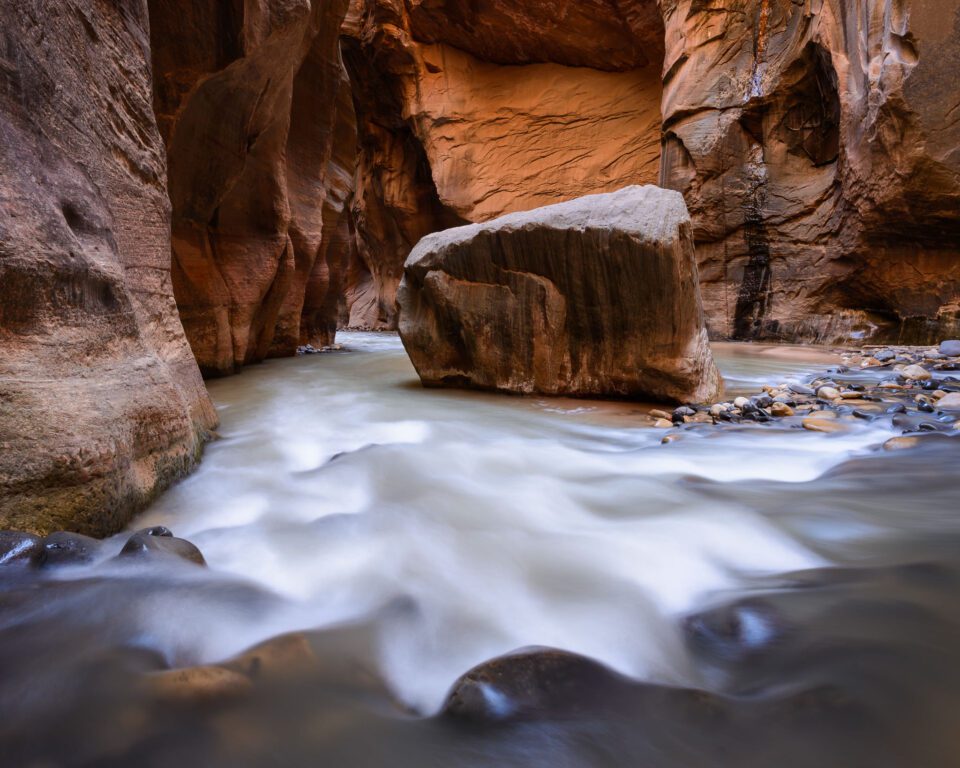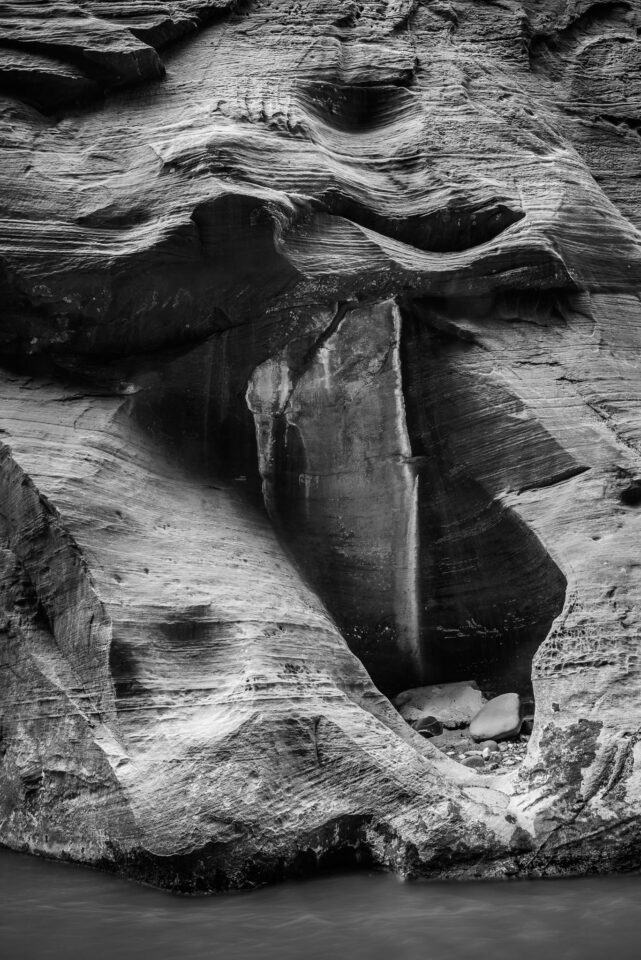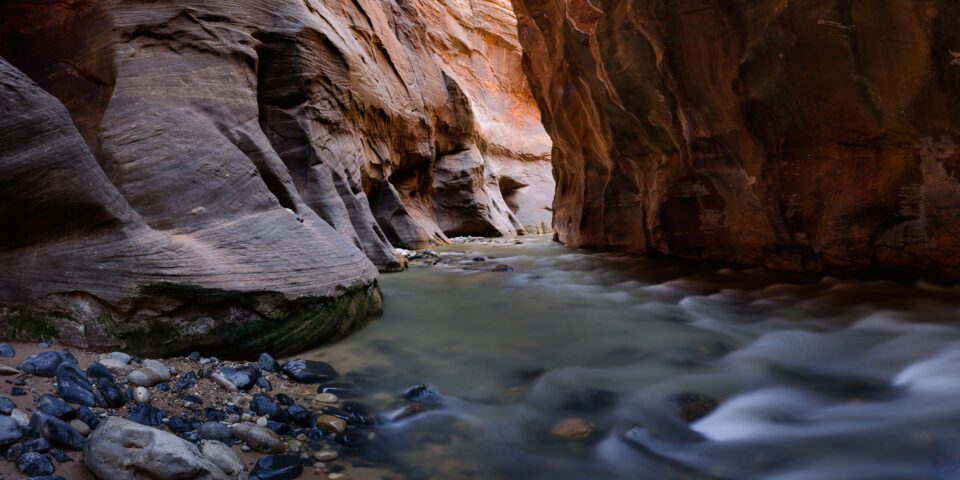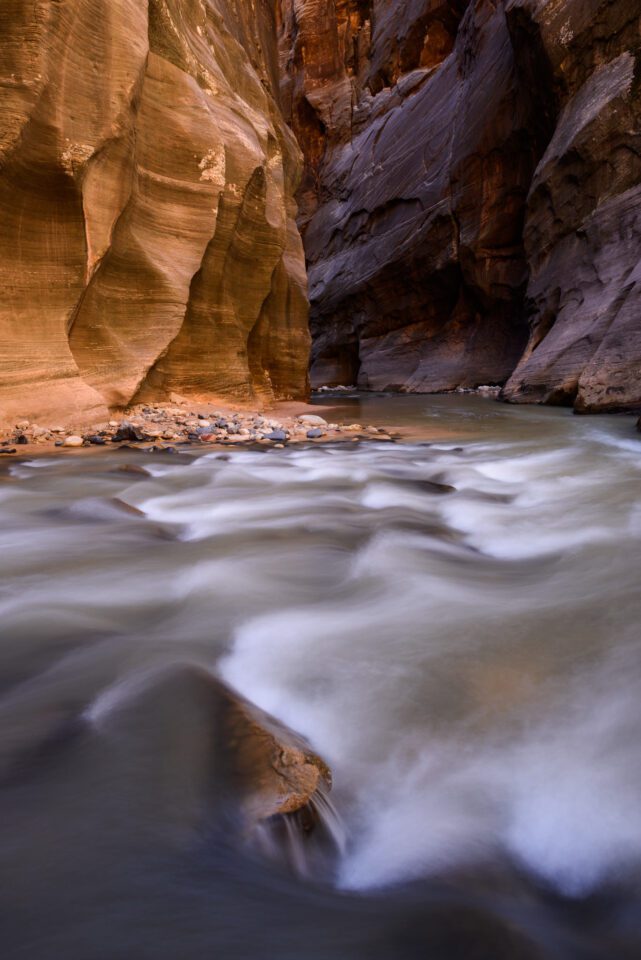Perhaps the most famous sight in Utah’s Zion National Park is the Narrows, a slot canyon carved by the Virgin River. The dramatic patterns in these sandstone cliffs are some of the most beautiful landscapes in the country, making for incredible images. I had the opportunity to photograph this amazing sight last month, which was not a particularly easy endeavor. Some of the most beautiful parts of the Narrows are only accessible after hiking upstream through the river for several miles.
If you decide to hike up the Virgin River, the most important consideration is safety. The river moves very slowly, but it can get quite deep at parts. A drysuit (or wetsuit) is essential if you are making the hike during the spring, as I did. The river can get incredibly cold, and there is no way to quit mid-hike. A few companies right outside Zion rent drysuits, although you need to arrive early in the morning – 7AM or so. By 9AM or 10AM, most places will be out. If you photograph the Narrows during summertime, a drysuit may not be necessary.
There are a number of islands and river banks along the way, which makes it easy to catch your breath if you need to. These also are the best places to take photographs, assuming that they provide the perspective you want. If it weren’t for places to rest, this hike would be even harder – several miles/kilometers though the middle of a river is extremely exhausting.
Another important consideration is to keep your camera equipment dry. This can be tricky. If you walk through waist-high water – or, on some days, even deeper – there is no perfectly safe way to carry a camera (unless you happen to use an underwater housing). This is particularly true walking through a stone-filled riverbed; I nearly fell a few times, and I saw several people who did.
I was lucky that my camera didn’t get wet, but I also took as many steps as possible to prevent any water damage. I only had a single camera and lens, which meant that I didn’t need to worry about changing lenses in the middle of the river. I hung my tripod off the side of my bag, since it could get wet without a problem. More importantly, my camera was inside of a kayaking dry bag, which itself was inside of a trash bag. Even if I fell – in theory – no water would reach my camera. That said, I’m glad I didn’t have to test it!
If you have a spare camera, you might consider bringing it along instead of your main one. Although I brought my main camera, there were a few times that I would have preferred a backup instead.
In terms of equipment, the most important gear to bring is a wide-angle lens. For the most part, the Narrows are so narrow that it is difficult to use anything other than a wide-angle. However, this is a generalization. There certainly are wonderful detail shots at certain points along the hike, so feel free to bring a telephoto if those are the photos you want to take.
If your lens allows, I also strongly recommend a polarizing filter. There are so many sources of glare in the Narrows – the river, the canyon walls, and even tree leaves – and a polarizer will make your images significantly simpler. A tripod also is a necessity; the Narrows are so dark that your shutter speeds may be several seconds long – even in mid-day. Plus, the water in your photos will look more natural with a slow shutter speed.
One of the most difficult parts about photographing the narrows is avoiding people in your images. Countless times, other hikers passed through the frame that I had set. There’s nothing wrong with this at all – the Narrows are a beautiful place, and thousands of people enjoy them every day.
As a photographer, though, I often prefer to take landscape images without other people in the frame. I was lucky enough to visit the Narrows during the spring, which meant that they weren’t particularly crowded. Even then, though, I had to wait several minutes for people to leave some of my images. I imagine that this would be even more problematic during the summer.
If you don’t want to wait a few minutes for people to cross through your frame, you might consider blending two photos together. For example, take an image with people in one part of your frame, then a second once they move to a different part. Layer the two photos, then blend out the people in Photoshop. Although it isn’t perfect, there may be no other way to take the photos you want on a crowded day.
Finally, it is worth noting that the Narrows can change significantly at different times of year. There are a few points along the hike where full-grown trees have taken root; these look beautiful during fall and late summer. Unfortunately, none of them had bright leaves while I visited – all the more reason to return!
I also visited just a small section of the Narrows hike (up to the “Wall Street” section). There are countless other landscapes to visit on the Virgin River, including some that have waterfalls and even more trees. If you are in Zion for a while, I strongly recommend exploring. Zion, like all National Parks that I have visited, is only crowded at the most famous spots. There are people everywhere, of course, but it is easier than you’d think to find an amazing place all to yourself.
Although I only had a single day to photograph Zion’s Narrows, it was one of the most memorable days of my life. The hike is tiring and cold, but it was completely worth the effort – both in photographs and in memories.
The post Photographing the Narrows in Zion National Park appeared first on Photography Life.












